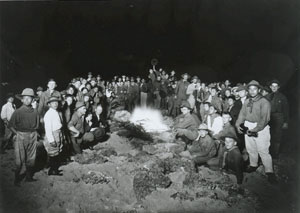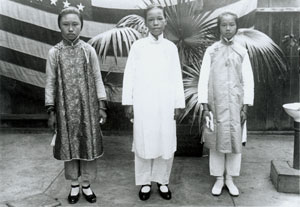Themes: Gender
Marking the presence of women in the historical documentation of Hawai'i has been an on-going project for scholars in many fields, and several bibliographies on women in Hawai'i are available. However, as we have suggested elsewhere, the book-length historical accounts have been overwhelmingly centered on women of the ruling and elite classes, Haole and Hawaiian. However, stories of working class women can be found in various oral history collections as well as in scattered journal articles. One recent important addition has been the special issue of Social Process in Hawai'i (vol. 38, 1997) with its eclectic collection of articles and literary pieces by and about women in Hawai'i.

In this section on gender, we want to recognize and encourage continued exploration of the position of women historically in Hawai'i; that is, gender (female) as a critically important element that intersects with and complicates other themes suggested in this collection. However, additional approaches are necessary. One approach would pursue analysis of the construction of gender (female and male) over time and within various ethnic and social communities, through topics of particular importance in the Territorial period (such as intermarriage or the Girls' Industrial School presents). Another would be the examination of representations of gender. A semiotics analysis such as Kathy Ferguson and Phyllis Turnbull's work on the highly masculinized military presence in a highly feminized and eroticized Hawai'i is an excellent model of how such examinations can proceed. Some of Haunani-Kay Trask's essays examine gendered representations of Hawai'i, as do Jon Goss' articles on tourism.

"Women in Hawai'i: Sites, Identities and Voices" Social Process in Hawai'i 38 (1997). Eds. Joyce Chinen, Kathleen Kane and Ida Yoshinaga. Honolulu: University of Hawai'i Press, 1997.
Ferguson, Kathy and Phyllis Turnbull. Oh, Say, Can You See?: The Semiotics of the Military in Hawai'i. Minneapolis: University of Minnesota Press, 1999.
Glenn, Evelyn Nakano. "Race, Gender and Citizenship in Pre-War Hawai'i." Paper prepared for the Association of Asian American Studies, Pacific Region Conference, March 24-26, 1996.
Goss, Jon. "Placing the Market and Marketing Place: Tourist Advertising of the Hawaiian Islands." Environment and Planning D: Society and Space. 11:6 (1993) 663-683.
Grimshaw, Patricia. Paths of Duty: American Missionary Wives in Nineteenth-Century Hawai'i. Honolulu: University of Hawai'i Press, 1989.
Historians Committee Foundation for Hawai'i Women's History. "The Written Record of Hawaii's Women: An Annotated Guide to Sources on Information in Hawai'i." 1984
Hori , Joan. " Japanese Prostitution in Hawai'i During the Immigration Period." Hawaiian Journal of History, XV, (1981), 113-124.
__________ . "Women in Hawai'i: A selected Bibliography of Materials in the Hawaiian Collections," 1984.
Linnekin, Jocelyn. Sacred Queens and Women of Consequence: Rank, Gender and Colonialism in the Hawaiian Islands. Ann Arbor, MI: University of Michigan Press, 1990.
Quisenberry, M.D., Walter B. "Was 'Controlled' Prostitution Good for Hawaii?" Journal of Social Hygiene, vol. 39, no. 7, Oct. 1953, 312-22.
Trask, Haunani-Kay. From a Native Daughter: Colonialism and Sovereignty in Hawai'i. Monroe, ME: Common Courage Press, 1993.
Wuthnow, Julie. "Haole Homo: Complicating Queerness in Honolulu." Office of Women's Research Working Paper Series, vol. 4. Ed. Louise Kubo. Honolulu: University of Hawai'i, 1995, 46-52.
